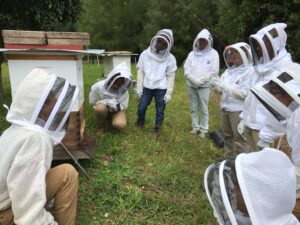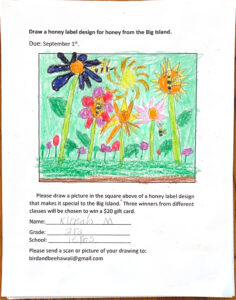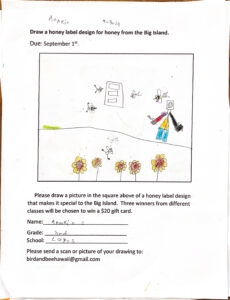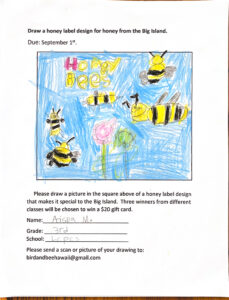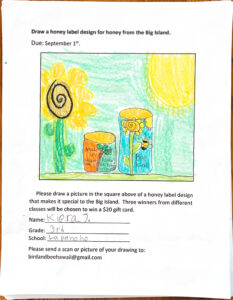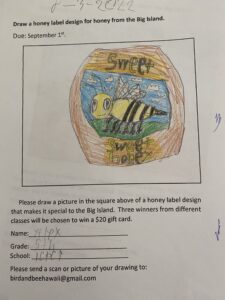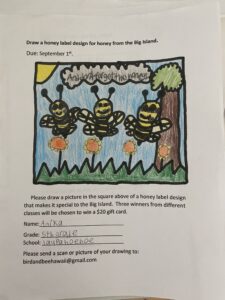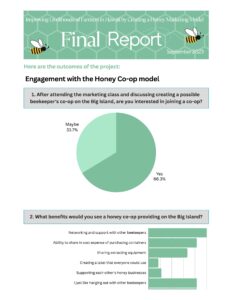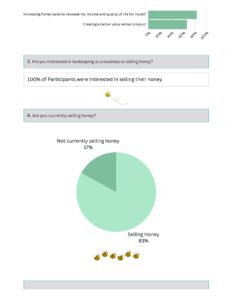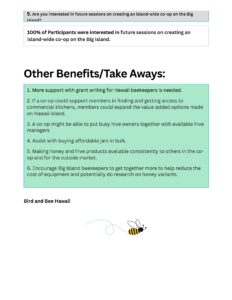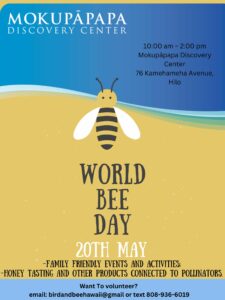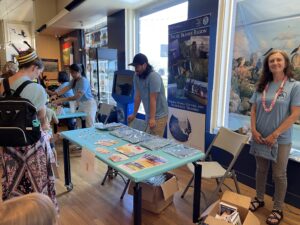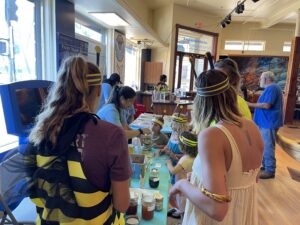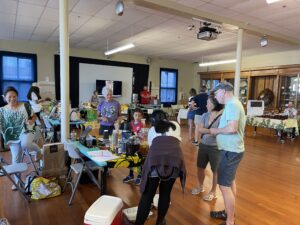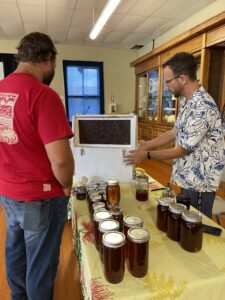Final report for FW22-409
Project Information
Problem: Most small farmers on the Big Island of Hawaii have low incomes and minimal support resources. They need additional revenue streams to make their farms successful. Can the Hilo/Honokaa area of Hawaii support the marketing efforts of a group of farmers who have been trained at Bird and Bee Hawaii, an on-farm apiary and education center using malama-aina traditional Hawaiian concepts that emphasize balance, reciprocity, and sustainability?
Research: This grant-funded market researched the viability of training a group of farmers, including veterans identified by Ho'ola Farm, in honey marketing procedures and created a group that formed a marketing model based on identifying the unique attributes of the local honey and using labels an Instagram site, and Hawaii Coastal Honey website which highlights both the marketing model and the special qualities of the honey.
Significance: The project has increased incomes of some struggling small farmers, thereby improving the quality of rural life in a poverty-stricken area that has great potential for producing large amounts of high-quality honey. Because the climate in the area is conducive to frequent honey harvesting and hive division, the farmers have marketable honey in a short time frame, which enables them to creating beekeeping related income quickly.
Dissemination: Brochures highlighting the results of the marketing research and creation of a cooperative marketing model will be disseminated using newsletters, bulk e-mails, an Instagram site, a website, and local partners such as Ho'ola Farms, Kohala Center, and the Hilo Small Business Development Center as well as on farmer forums.
- Trained 25 beekeepers in business and marketing principles. The beekeepers will be local small farmers and veterans who have already been trained as beekeepers at Ho'ola Farms, a veteran service center and farm.
- Created a honey marketing research plan.
- Worked together to build a cooperative honey marketing model for farmers and veterans.
- Created a branded honey for the Honoka'a/Hilo area on the Big Island of Hawaii.
- *In Progress -Raise 25 farmers and military veterans (35% veterans) out of poverty by increasing farm incomes.
- Disseminate the results of this research to other farmers and communities using USDA and beekeeper organization newsletters, articles in publications, various types of social media, bulk e-mails, and classes and presentations.
Cooperators
- - Technical Advisor
- - Technical Advisor (Researcher)
Research
RESEARCH OBJECTIVES:
The primary goal of the research was to determine the effect on farmers, veterans, and the community of cooperatively produced and marketed honey with labeling that reflects the unique nature of both the honey and the community.
Purpose: To increase the financial security and general quality of life of 25 under-served and/or veteran farmers by providing beekeeping training and assistance in creating a cooperative honey marketing model.
Research Design: Research has been low-key and is continuing. Only the baseline initial questions completed and the remaining research will depend on Google surveys, phone and Zoom interviews with project participants and members of the local community. Materials will be widely known and easy to use. The tone of the research questions will be in keeping with the cultural attitudes of local farmers toward community relationships, relationships with the environment, and the definition of business "success". In Hawaii, this attitude toward people and business would be referred to as "Aloha" and the relationships with the environment and its creatures would be referred to as "Malama-aina".
Research Timing and Deadlines: Research began on April 1, 2022, and ended on September 1, 2023.
Target site: Honoka'a, Hawaii
Basic Background Marketing Information:
Background: The 2020 Honey.com Attitudes and Usage study was conducted with the following objectives:
The goal of that study was to track attitudes, awareness, and usage of honey among a general population sample and a newly identified target audience called "Goodness Seekers".
This target audience is similar to the previous "LOHAS", "Lifestyles of Health And Sustainability."
This was an online survey among 2,000 U.S. consumers, with basic demographics balanced to U.S. census. Its basic findings informed our more targeted study.
Some key findings include:
- New Product Introductions (honey.com indicates that awareness had moderate declines for all sweeteners, including honey vs year ago in 2020).
- However, usage has increased by ~ 10% points for all sweeteners including honey vs 2019.
- Perceptions for honey remain strong, and perceptions that honey has health benefits increased vs 2019.
- The number one preferred sweetener is honey, beating out white sugar for the first time in five years.
- The morning occasion remains strong ~ 50% of occasions.
- Most honey purchases are planned driven by pantry refill, and recipe needs. At the shelf, consumers are influenced by brand trust, price, and honey claims as drivers of choice.
- Positive story recall is up Year Over Year and negative story recall declined. Positive news is driven by perceived “better for you” sweeteners.
- The new target, Goodness Seekers, identify honey as their favorite sweetener, 2:1 vs white granulated sugar.
- The Goodness Seeker is more sensitive to sustainability concerns and more likely to understand honey consumption is good for the bees.
RESEARCH PLAN:
- Determined the financial feasibility of cooperatively-produced honey that is Hawaii branded honey is valuable. Methodology: Refer to existing studies performed in other areas. Create financial projections based on the amount of harvest.* Determine target audience. Determine venues such as farmer's markets and local stores. Materials: Microsoft Word, XCEL, Quickbooks, online research. Findings: The financial feasibility of a cooperative model of selling honey on the Big Island is excellent. There are currently three popular co-ops that continue to expand on the Big Island. They are the coffee co-op which has a powerful presence in the coffee industry; the Cacao co-op continues to expand in popularity as small cacao farmers increase and the boutique chocolate industry increases; and the ulu cooperative which has begun to create many different products and includes farmers from across the island. According to the Kohala Center, creating a honey co-op has very good potential based on the other cooperatives that are currently thriving and growing in Hawaii. Out of the research conducted, there is a strong desire to build a honey co-op within a group of women beekeepers.
- Determined the increase in awareness of honeybee contribution to sustainability. Post questionnaires indicate that many people are only somewhat aware of how important pollinators and honey bees are to the environment. After presentations, students in PreK-12 school settings as well as farmer markets and Honokaa public library were more aware of the important role that bees play in agriculture beyond honey. Honey is also viewed as a food that is nutritious compared to other sweeteners and a product they would like to consume on a daily basis. The label contest allowed students to understand the importance of marketing. Marketing honey was a new concept for students who hadn't considered the importance of marketing previously. The label contest allowed students to feel like they were putting into use what they learned during the presentation. It also made them aware of how to sell honey based on its important aspects. Pre/post questionnaires have been prepared to sample local consumers' and local students' awareness before and after this project. Materials: Printed and online questionnaires.
- Determined the effects of marketing a cooperatively-produced honey that particularly relates to a small, close-knit community. In other words, how much does the public respond to the story of the bees, the community, and the producers? Methodology: Tracked locations of greatest sales, interviewed store owners and the farmers who man the booths at the farmers' markets as well as interviews with selected retail customers. Materials: Phone, online, and Zoom interviews. Analyze financial records in QuickBooks. *IN PROGRESS **More training needs to be offered to all beekeepers and farmers on the Big Island who sell products on how to use accounting tools. I found that the participants did not have one means of tracking income. Participants' willingness to use Quickbooks spreadsheets was limited due to their ability and comfort of use and cost of the program.
- Determined which sizes of jars are likely to produce the most profit. Methodology: Online research and interviews with successful beekeepers. Phone, online and Zoom interviews. Materials: Manufacturers' catalogs. Findings: Jar sizes that were most successful in being used to sell honey by beekeepers whom I worked with so far determined that they prefer smaller jars (8oz or 12oz jars) due to the limited amount of honey that they have also due to the historically limited availability of jars on the Hawaii Island, many people have become used to using what is available which are 4oz,8oz and 12 oz ball jars. Finding other types of jars on Hawaii Island is difficult and extremely cost prohibitive. The jars provided were hexagon shaped and better quality. Many participants have commented on how this jar design looks nicer as gifts.
- Assisted with design of the honey labels by determining what art and what type of storytelling on the label attracts consumers. Methodology: Show sample designs to potential customers and do a simple survey. Materials: Sample designs from artist. Printed and online surveys. Track results of surveys of schoolchildren's label preferences. Findings: Elementary and Secondary students preferred labels with pictures of bees with flowers and cute faces. Adults preferred pictures of places. The best design is on the label created which is an artistic rendition of a waterfall in Waipio Valley on the Big Island. All participants felt that including information about the floral types on the label was valuable.
- Tracked the financial benefits of the project on the participants. Methodology: Trained the participants in good record-keeping. Interviewed each participant by phone and/or Zoom call after they have produced and marketed honey for at least six months. Materials: QuickBooks, Excel spreadsheets, Zoom. Training for good record-keeping is in progress. This area of training requires possibly a targeted project or program for beekeepers who are also first-time small business owners. Financial experience and use of record keeping varied from person to person so information about the financial benefit varied among participants.
- Tracked the positive effects on the community, including both financial (increased incomes) and quality of life. Invite community businesses like restaurants and shops to participate and report increased business and sales. Methodology: pre- and post-questionnaires, phone and Zoom calls. Materials: printed and online questionnaires, Zoom, Excel spreadsheets. Participants felt that these were the top four positive effects of creating and joining a co-op: 1. Networking and support with other beekeepers 2. Ability to share in cost expense of purchasing containers 3. Supporting each other's honey businesses 4. I just like hanging out with other beekeepers 5. Increasing honey sales to increase my income and quality of life for myself
- Created a Work Product: A printed Research Study with the results of the above criteria for online distribution and sharing with farmers and agricultural professionals. Methodology: Preparation of research study compiling results of all project research. Materials: Microsoft Word, Excel spreadsheets, Google Drive, Google Sheets. Please click on the follow link:
Final Report for Improving Livelihoods
All data was verified, validated, and cross-checked.
MARKETING HAWAIIAN HONEY FOR UNDERSERVED PRODUCERS
HONEY IN HAWAII Currently, Hawaii is home to many honey companies, some small, family-run ones and larger firms that have hives in several locations. Hawaii ranks number 1 in the US for honey production per colony, with an average production of 112 lbs/colony according to the 2016 National Agricultural Statistics Service, the most recent official figure. However, unofficially, in 2022, smaller-scale Hawaiian apiaries reported production of up to 200 lbs/colony. – the highest in the nation. In 2019, The U.S. Department of Agriculture reported that Hawaii produced 1,280,000 pounds of honey, sourced from 16,000 hives, and reported that honey production in Hawaii was $4.1 million/ year in 2016.
Hawaii is known for producing some of the world’s rarest honeys such as Ohia Lehua honey. Hawaii Island has a remarkable diversity of ecosystems and climate zones. The culture of the island includes traditional knowledge that can enrich the management of its natural resources. It is estimated that Hawaii contributes $212 million per year in pollination services. But Hawaii is also a large honey producer, and in 2018, it ranked first in the country for the quantity of honey it produces per hive.
Abundant diverse plants and year-round forage conditions make this a great place to produce honey. Honey from Hawaii is prized on the market, with special flavors and textures commanding high prices. Macadamia nuts, avocado, coffee, citrus, and lychee are just a few Hawaiian crops that require honeybee pollination for fruit yield.
Having healthy honeybees in Hawaii has great value at home and impacts agriculture worldwide. In addition to the variety of special products Hawaii’s honeybees produce including honey, wax, and pollen, the state is a key provider of queen bees to the mainland US and Canada. Hawaii’s year-round queen-rearing capacity is a critical resource to North American agriculture which relies heavily on honeybee pollination. Queen bee production in Hawaii was estimated to be around $10 million/ year in 2016 and has continued to rise.
Honeybees are responsible for producing about 75% of the food we eat. If we lose honeybees food will get much more expensive due to the low supply, and the variety of foods we enjoy will be curtailed. Some parts of the world could be struck with famine without honeybees.
HONEY Honey has been used in food for at least 6000 years, mostly as a sweet source for much of the world’s population. The first written reference to honey, inscriptions on a Sumerian tablet dating back to 2100-2000 BC, mentions honey’s use as a drug and an ointment. There are references in the Bible to honey’s healing qualities and it is also mentioned as a delicious food source. It has been used in food for at least 6000 years, mostly as a sweet source for much of the world’s population. There are petroglyphs in Spain from 9000 BCE showing a person collecting honey with bees flying around them.
MULTI-FLORAL HONEY is made by honeybees from a variety of floral sources. Most honey falls into this category. If you are not really sure if your bees made your honey from one source, you would legally need to identify it as multi-floral.
UNIFLORAL HONEY is a type of honey that has a distinctive flavor or other attributes due to its being predominantly from the nectar of a single plant species. It is stored and labeled separately in order to command a premium price. While there may never be an absolute unifloral type, some kinds of honey are relatively pure due to the prodigious nectar production of a particular species, such as citrus (orange blossom honey), or there may be little else in bloom at the time. A beekeeper should not make the claim that honey is unifloral unless he or she is quite sure that there were no other species blooming at the time that could provide nectar for bees.
MARKETING HAWAIIAN HONEY
Financial feasibility of co-operatively produced honey that is Hawaii-branded.
Sources: Online stores of existing Hawaiian honey companies. Tracking sales of participating beekeepers. Tracking sales of Hawaii-branded honey in Honokaa stores.
Currently, Hawaii is home to many honey companies, small family-run ones and larger firms that have hives in several locations. Hawaii consistently turns out high quantities of honey per hive, and in 2018, it produced 103 pounds per colony – the highest in the nation. In 2019, the yield had dropped a bit, but it still ranks as one of the most efficient honey-producing states.
- Honey sales are very successful online, using Amazon or other platforms, or creating websites for the farm business. The most successful marketers use both their own and other platforms. Bird and Bee Hawaii LLC markets on its own Instagram page and website, birdandbeehawaii.com.
Attractive pictures of honey in the jars, along with brief but educational text are likely to encourage healthy honey sales.
Location of greatest sales: Honokaa Tourism, Hilo Farmers Market.
- A valuable source of sales for Hawaiian honey producers is the large number of tourists who pass through and want to take home a taste of Hawaii. Forming relationships with local businesses willing to market your honey, selling at farmers' markets, or having your own roadside stand are all venues that should boost sales. Using small, sample-size jars could help in capturing tourist sales.
- Floral sources on the Hamakua coast vary greatly and include: eucalyptus, lilikoi, ginger, strawberry guava, Christmas berry, coffee, Ulu, macadamia nuts.
- If your honey is unifloral, first, explain how you can make that claim, e.g., “we only harvested during the bloom time of this flower and there were no other significant flowers blooming in the vicinity at the same time.” You should also mention a few recognizable characteristics like color, texture, and flavor that indicate the floral source.
- If the honey is multi-floral, don’t make claims that identify specific floral sources, but describe the typical nectar-producing plants that were blooming at the time your bees were foraging. You could also add a sentence about the benefits of eating honey from a variety of sources which add interesting qualities to your honey.
- Continuing sales to satisfied existing customers will form the backbone of your business. Include your flyer in boxes, save customers’ contact info, and work to build relationships with your customers.
Beekeepers should learn the predominant nectar sources of their region and can increase their income if they plan harvests to keep especially fine ones separate. This could also be a valuable future research project.
ADDITIONAL DECISIONS TO BE MADE ABOUT HONEY PRODUCTION
Increase in awareness: How will the increased awareness of honey specific to the Big Island be promoted? Although many platforms were discussed. Upon creating a Honey Co-op, new ideas and formats will be created.
Raw or processed:
Based on its texture, honey can be either liquid, granulated, creamed, chunked, or can be of an unprocessed form (called comb honey).
Depending on the level of processing, honey can again be divided into raw and pasteurized forms. Raw honey is the crude form. It is directly extracted from the comb before being sent for any refinement. It has the highest therapeutic value. Pasteurized honey is obtained after heating and straining it to get rid of bacterial or fungal contamination.
All Bird and Bee Hawaii honey is raw, and filtered. It is intended that the project sell raw, filtered honey under the label, ‘Hawaii Coastal Honey’.
BIRD AND BEE HAWAII, LLC https://www.facebook.com/birdandbeehawaii/
Bird and Bee Hawaii, LLC is a woman-owned and run company located in Honokaa on the Big Island of Hawaii, which is dedicated to offering education workshops in a classroom building called the Bee Barn. The business also provides equipment, hive removal services, and mentoring to beekeepers. Bird and Bee Hawaii’s mission is to support local hobby beekeepers and their hives by creating an environment that provides a safe and educational atmosphere for students of all ages to learn about the importance of bees and beekeeping.
Providing marketing and business training to participating beekeepers:
With the help of a USDA SARE Farmer/Rancher grant, the business is expanding to provide marketing training to both existing beekeepers who want to market honey and related items, and those who want to learn how to keep bees and market their honey and other products. All participants will learn how to manage a hive, pests of the hive, products of the hive, and the natural cycle of honeybees as a superorganism.
Financial benefits for the participants:
Bird and Bee Hawaii has presented marketing classes for approximately 50 students who have completed the apiculture classes. Interest runs from having a roadside stand at their own farm to having a permanent booth at various Big Island farmers markets all the way to learn about online marketing and developing their own websites to sell their honey and honey products. Susan Collins, the owner of Bird and Bee Hawaii LLC, polled the students to see if they are interested in marketing their product(s) under one Big Island label. She will provide grant-funded labels for farmers who want to try cooperative labeling and marketing.
Unsolicited Review from a satisfied student:
“. . . . I took a month-long beekeeping class with Susan and learned so much. For decades I have wanted to learn how to keep bees and after my four weeks, I feel like an informed confident novice! I appreciated the basics about bees and getting supervised instruction on getting into the hives, identifying the queen, and knowing what to look out for long-term in the hives. The small group made it easy to connect to Susan and others.”
USDA SERVICES SUPPORT THE BEEKEEPING INDUSTRY
Increase in awareness of honeybee contribution to sustainability:
With the arrival of Varroa on Oahu and Hawaii Island, the feral bees have been largely lost, which means that managed pollinators play an even more important role to provide adequate pollination for farmers. Biosecurity is key to keeping export markets strong, we must prevent the introduction of Africanized bees and other invasive bee pests.
Hawaii's agriculture relies heavily on honeybees for pollination. Many of our crops would not have pollinators without honeybees. Macadamia nuts, avocado, coffee, citrus, and lychee are just a few crops that require honeybee pollination for fruit yield. If you like to eat you need honeybees!
For information on the USDA bee program on the Big Island, contact HDOA at (808) 974-4138.
From https://hdoa.hawaii.gov/pi/program-info/
ADDITIONAL INCOME FROM BEES
Track the Financial Benefits of the projects on the participants: Having healthy honeybees in Hawaii has great value at home and impacts agriculture worldwide. In addition to the variety of special products Hawaii’s honeybees produce including honey, wax, and pollen, the state is a key provider of queen bees to the mainland US and Canada. Hawaii’s year-round queen-rearing capacity is a critical resource to North American agriculture which relies heavily on honey-bee pollination.
Did You Know?
Honey is the only food that will not spoil. This is due to its low moisture content. Bacteria cannot survive in a medium with such a high osmotic pressure.
However, honey harvested before it is ripe has a higher moisture content and may be vulnerable to spoilage.
Honey is hygroscopic and absorbs water from the atmosphere if it is not stored in a well-sealed container.
Honey can be unifloral (from a single flower type) or multifloral (multiple species of flowers); biochemical profiles of both classes vary accordingly.
Honey is produced by six to eleven of the approximately 20,000 species of bees. The bees (most commonly, Apis mellifera) drink nectar from a flower and blend it multiple times with salivary enzymes (diastase and invertase) in their honey sacs.
The floral nectar is chemically transformed into honey when the complex sugars are enzymatically broken down into glucose and fructose, and excess water is evaporated.
Yes, nectar and honey are different! They differ based on their chemical composition. Nectar is an aqueous solution of sugars, amino acids, proteins, lipids, minerals, and other components. Honey is more processed (by the honeybees) and richer than nectar.
There are over 300 types of honey worldwide, each produced by incredible honeybees that play an enormous role in the pollination of our ecosystem.
What Are the Different Types of Honey? Based on its texture, honey can be either liquid, granulated, creamed, chunked, or can be of an unprocessed form (called comb honey).
Depending on the level of processing, honey can again be divided into raw and pasteurized forms. Raw honey is the crude form. It is directly extracted from the comb before being sent for any refinement. It has the highest therapeutic value. Pasteurized honey is obtained after heating and straining it to get rid of bacterial or fungal contamination.
Another classification of honey is based on the nectar source. Honey produced by bees that drink nectar from a single species of flowers is unifloral honey. But if the nectar comes from more than one species of flowers, then it is multi-floral honey.
Increase in awareness of the effects of beekeeping on sustainability:
Bird and Bee Hawaii has presented marketing classes for approximately 50 students who have completed the business apiculture classes. Interest among the students runs from having a roadside stand at their own farm to having a permanent booth at one or more of the Big Island Farmers Markets all the way to learning about online marketing and developing their own websites to sell their honey and honey products. Susan Collins polled students to see if they are interested in marketing their product under one Big Island label. She provided grant-funded labels for farmers who wanted to do cooperative labeling and marketing. The honey was marketed via her business’ Instagram account and other means according to each individual.
DIRECT SALES VS WHOLESALE TO STORES:
Direct sales are the choice of many beekeepers who consider themselves hobby beekeepers, or who want to build small honey businesses. These direct sales can be accomplished at farmstand or roadside locations.
For beekeepers who want to expand beyond simple direct sales, but still want to market at the direct level, the Honokaa area abounds in farmers market selling opportunities. Some of these are:
WAIMEA TOWN MARKET-Saturdays, 7:30 to noon
THE WAIMEA MID-WEEK MARKET-Wednesdays, 9:00 am to 2:00 pm
THE KAMUELA FARMERS MARKET-Saturdays, 7:30 am to 1:00 pm
BIG ISLAND FARMERS MARKETS—including HILO FARMERS MARKET (largest) MARKET HOURS: Open every day till it’s gone. Big Market Days * are considered to be Wednesday so the recommended days to visit and shop are WEDNESDAY and SATURDAY 6:00 am - 4:00 pm. This category also includes Laupahoehoe, Honokaa, Waimea, and Puna farmers markets.
The Hilo Farmers Market has over 200 Vendors: Local Farmers, Retailers, Food Trucks, Restaurants, Artisans and Crafters. Small Market Days Monday, Tuesday, Thursday Friday, and Sunday 7:00 am - 4:00 pm. have 20 to 30 Vendors: Local Farmers, Retailers, Food Trucks, Restaurants, Artisans and Crafters.
MARKET AT THE MILL-Saturdays, 7:00 am to 2:00 pm. Mountain View (13 mi. from Hilo)
KEAAU VILLAGE FARMERS MARKET-Tues. through Saturdays, 7 am to 5 pm. Keaau (8 mi. from Hilo)
PAHOA COMMUNITY FARMERS MARKET-Sundays 7:00 am to 2:00 pm-Pahoa (15 mi. from Hilo)
INSTAGRAM SALES ON BIRD AND BEE HAWAII Instagram page
Bird and Bee Hawaii finds Instagram to be an excellent venue for honey sales. Students’ honey that is properly labeled and of acceptable quality can be sold, with permission, through the Hawaii Coastal Honey Instagram page. (#hawaiicoastalhoney)
If there is interest in a marketing cooperative, the cooperative can also use the #hawaiicoastal honey Instagram page or the website hawaiicoastalhoney.com for marketing or develop their own, with mentoring from Bird and Bee Hawaii.
Price, volume, values, weather impacts, supply, and demand—the market and all the economic factors surrounding it can be complex to track and understand. From the smallest farmer to the largest grocery store chain, all of American agriculture is impacted by the trends and prices within the marketplace. Having the right information at the right time is key to achieving success. [AMS webpage www.ams.usda.gov]
WAIMEA FARMERS MARKET - Parker School or The Paniolo Stables
- To continue as a stable entity and to increase its appeal to new and repeat customers, Waimea Town Market, LLC admits only vendors who are committed to weekly attendance at the Saturday Market.
- The Market has a capacity for approximately 50 Vendors. There are currently two categories of vendor: full-time and seasonal. A limited number of seasonal vendors may be accepted for admission to the Market at the discretion of the Owner, depending on space availability.
Hamakua Harvest Farmers Market (Open Sundays)
The Farmers’ Market at Hāmākua Harvest is located at the intersection of Māmāne Street and Highway 19 just outside of Honokaa. Our hours are Sundays from 9 a.m. to 2 p.m. We have a wide variety of vendors offering fresh, locally grown produce, value-added products, and ono food. Masks recommended and social distancing applied, mahalo!
SNAP/EBT purchases are welcomed, and most of our vendors accept SNAP/EBT at their booths. SNAP/EBT participants interested in using their SNAP dollars should visit the welcome booth for HarvestBucks so they may purchase products ranging from fresh produce and baked goods to honey and cold takeaway items.
The Market’s weekend workshops, informational booth, and youth-focused activities are designed to respond directly to the needs and interests of the local community.
The Farmers’ Market offers a unique, celebratory character with weekly entertainment and education programs reflecting the culture and history of the Hāmākua region, and provides a vibrant, social gathering place benefiting the community as a whole.
Contact: Kiʻilani Spencer, Market Manager, [email protected]
The Farmers’ Market would like to thank Big Island Resource Conservation and Development for helping to establish Hāmākua Harvest’s Farmers’ Market by sponsoring us for a USDA Farmer Market Promotion Program.
POTENTIAL AREA STORES THAT CARRY LOCAL PRODUCTS AND SUPPORT LOCAL FARMERS
Anuenue Natural Foods
Healthways
Island Naturals (Hilo)
Island Naturals (Kona)
Keaau Natural Foods
Sack N Save (Puainako)
Island Naturals (Kona2)
Island Gourmet Market (Kohala)
Foodland 1 (Waimea)
Foodland 2 (Porter Ranch Center #109 Kamuela) 808-885-2022
KTA Super Stores (Downtown Hilo) 808-935-3751
KTA Puainako St. (Hilo) 808-959-9111
KTA (Waimea) Waimea Center 808-885-8866
Healthways Parker Ranch Shopping Center Kamuela (25.3 mi from Honokaa) 808-885-6775
Malama Market Honokaa 808-775-0631
Abundant Life Natural Foods 808-935-7411
The Locavore Store (Hilo) All local products, 100+ farms and artisans – will sell in-store and showcase online.
Price, volume, values, weather impacts, supply, and demand—the market and all the economic factors surrounding it can be complex to track and understand. From the smallest farmer to the largest grocery store chain, all of American agriculture is impacted by the trends and prices within the marketplace. Having the right information at the right time is key to achieving success. [AMS webpage www.ams.usda.gov]
Shipping fresh agricultural foods from Hawaii to the mainland:
https://www.aphis.usda.gov/publications/plant_health/fs-ship-mail-from-hawaii.pdf
This information is subject to change. For the most up-to-date information, contact your local APHIS office:
Honolulu (808) 834-3220
Kona (808) 326-1252
Kauai (808) 632-2511
Hilo (808) 933-6930
Maui (808) 877-5261
References:
- https://beeswiki.com/hawaii-honey/
- “The Chemical Composition of Honey” Chemistry for Everyone, Journal of Chemical Education
- “Traditional and Modern Uses of Natural…” Iranian Journal of Basic Medical Sciences, US National Library of Medicine
- “Honey as a Complementary Medicine” Integrative Medicine Insights, US National Library of Medicine
- “Identification of flavonoid markers…” Journal of Agricultural and Food Chemistry, US National Library of Medicine
- “Potential biological activity of Acacia honey” Frontiers in Bioscience (Elite edition), US National Library of Medicine
- “Biochemical properties, antibacterial and cellular…” Food Chemistry, US National Library of Medicine
- “Honey dressing beneficial in treatment…” Indian Journal of Surgery
This project has been funded in part with Federal funds from the U.S. Department of Agriculture. The contents of this publication do not necessarily reflect the view or policies of the U.S. Department of Agriculture, nor does mention of trade names, commercial products, or organizations imply endorsement by the U.S. Government.
Please also refer to the Instagram page: Hawaii Coastal Honey and the website: birdandbeehawaii.com
This feasibility/marketing study is funded by a USDA WESTERN SARE Farmer/Rancher Grant.
It was prepared by Nancy Smith, owner of Palate Impressions, a consultancy firm located in Doniphan, MO. Ms. Smith has been writing studies for various state projects as well as numerous USDA projects since 2008.
It is the opinion of the author that the proposed project has a high degree of success due to the professional expertise of its key personnel, its location on the Big Island of Hawaii, the high amount of interest among area farmers and beekeepers, the amount of tourism in the area and an abundance of potential market outlets, including a dedicated Instagram page.
Research Outcomes
Recommendations:
- To create a strong honey cooperative, first start with a small core group of people (3-6 people) who are motivated to make a co-op and create bylaws by that group before beginning a cooperative that will be long-lasting.
- Reference the "How to Start a Cooperative" guide by the USDA. This guide gives step by step lessons on how to create a community supported co-op.
- Include educating children in elementary and secondary school classes in honey nutrition. This will encourage future generations to value and purchase honey.
- Create a presentation that will brought to five different central locations around the island to further strengthen a honey co-op on the Big Island.
- Offer two different classes to support members of a honey co-op. How to Effectively Market your Honey and How to Support your business through Record-Keeping
Education and Outreach
Participation Summary:
April 2022 - Label Design - A new label reflecting the values of beekeepers and blooms on the Big Island was created by a local graphic design studio - Soul Creative.
September 2022 - Bottles for honey, In Business with Bees, labels, and a printer were purchased for dissemination of honey were purchased.
April 2022- March 2023 - Market Honey - An Instagram page and website and brochures with the Hawaii Coastal Honey logo and information were created for use by members of the co-op and those selling honey. Instagram: hawaiicoastalhoney and website: hawaiicoastalhoney.com
August - September 2022 - In-person Beekeeping presentations in K-12 schools and In School Label design contest with classes (Honokaa, Laupahoehoe, and Hilo) (Relates to #3& #4) I met with a third-grade and fifth-grade class in Laupahoehoe school, a preschool nature school in Laupahoehoe, a Montessori K-7th grade school in Honokaa and a 12th grade Youth Challenge class from Hilo. I went to their schools in person except for the 12th class which came to my apiary for an in-person class about bees and honey. All groups participated in the label contest. There were three winners from the elementary school classes who won the gift certificates.
September 2022 - December 2022 - Marketing classes - 30 participants participated in three different free marketing classes that I held participants interested in the co-op aspect of selling honey and were actively collecting and selling honey, were given jars and labels. All participants received the "In Business with Bees" book.
April 2022 - April 2023 (ongoing ) Mentoring groups - Approximately 15 small groups of people participated in the mentoring Tuesdays (and sometimes Thursdays). They received personalized instruction on keeping healthy hives and collecting honey. They also received instructions on how to best market their honey and why receiving a fair price for the honey is so important.
May 2022, November 11, 2022, March 16, 2023, and May 2023Farmer's Market(and similar events) - May 26th Annual Honokaa Farmer's Market; 1st Annual Renaissance Festival; and Honoka'a Public Library - 2-4 hours was spent at each event. Approximately 170 Participants learned about bees, beekeeping, and honey.
May 20, 2023 - First Annual World Bee Day - May 20th, 2023 10-2 pm was another event where many beekeepers and members of the public learned about honey and the importance of purchasing local honey. Over 600 people attended. This was a great first-time turn out to an event that did not have funding and was promoted through word of mouth among local beekeepers, students, and participants of this project. About 20 different vendors participated including: non-profits, beekeepers, and educational environmental groups in the community. More participants for a co-op will be recruited here as well in the future. I will be holding this event again on May 18, 2024, due to its success. This is a great tool for networking and creating outreach to other beekeepers and bee enthusiasts in the community. We also plan to hold a co-op meeting at this event. Another beekeeper has taken the initiative (due to this project) to create a Wahine Honey Hui (a woman's honey cooperative) starting in October 2024.
May 2022 - March 2023 - Online research was conducted.
April 2023 - August 2023 - Post Research was completed.
Stakeholders: Under-served small farmers on the Island of Hawaii; Veterans from Holo'a Farms; local students for Field Day and classroom presentations, small businesses and farm owners on the Island of Hawaii.
Communication:
Social media sites for Bird and Bee Hawaii and Hawaii Coastal Honey are continuously updated to offer information. Sites include:
Website: birdandbeehawaii.com; hawaiicoastalhoney.com
Facebook: facebook.com/birdandbeehawaii;
Instagram: instagram.com/birdandbeehawaii/ instagram.com/hawaiicoastalhawaii/
Email and personal relationships through previous community programs - This was extremely effective in finding participants for all activities. It also gave me a chance to reconnect with past professional ties and create new ones.
Outreach Activities:
- 4 farm market/Renaissance Faire/Public Library educational demonstrations on honeybees, honey, and marketing products associated with raising bees. I gave four different educational talks on honey bees and the production of honey at the Hamakua Harvest Farmers Market; a fair; and a public library. This enabled me to reach out to possible new participants of the honey co-op; build rapport with community members; and educate the public on the importance of consuming local honey.
- 5 school in-person presentations on honey bees and honey in 2022. Schools are located in Honokaa, Laupahoehoe, and Hilo. Groups from K-12th grades were included. This increased awareness around pollinators; consuming honey as an alternative to sugar; and marketing honey.
- 1 marketing contest – All classes that participated had the option to take part in a new label design contest where three winners won a $25 gift card. Each class that participated was asked to make a logo based on the informational classes. The contest was held August- September 2022. The winners each received a gift card. This definitely motivated students to think a little harder about how to market honey and how to increase sales of honey.
- Ongoing mentoring sessions with students who have taken the Art of Beekeeping Class are invited to participate in weekly mentoring every Tuesday 9:30 am-12:30 pm (free of charge) at Bird and Bee Hawaii apiary. During this time, students share information about what they are doing to promote their products and assist with marketing products from Bird and Bee Hawaii honey as well as practice beekeeping techniques. This allows them to have experience with honey production, keeping bees, and building marketing skills. This is ongoing throughout the year.
-25 farmers and veterans marketing classes - These three sessions were useful for the following reasons:
- It gave a chance for beekeepers to network and share new ideas with each other.
- Beekeepers exchanged on ideas and interest around creating or improving their beekeeping businesses.
- Explanation of a honey co-op and any ideas around this group.
Education and Outreach Outcomes
I recommend the following:
- Create a World Bee Day Event annually which will assist with networking for beekeepers and a space for any forming co-ops to meet.
- A component of education about honey in schools as way to bolster public attitude towards local honey and supporting local beekeepers.
- Education around pollination and pollinators should be an ongoing subject in schools to support public opinion for beekeepers and the products and resources that they offer.
- Outreach to schools and high-needs areas also creates awareness in families that wouldn't otherwise receive the information disseminated.
- A co-op should be created by a group that come to an agreement about how it will be run before creating the structure of a co-op. Although there is a lot of interest in making a long-term co-op group, it would be helpful to add a component where I would go out to all of the different communities to pitch the idea. This was done when creating the Ulu co-op which has become successful. A core group of stakeholders need to making decisions together to make the group long lasting. .Bird & Bee Jar Labels 7.5 x 2.25_outlined Bird & Bee_Lid Label 2 x 2_outlined (1)

Examining a frame. Bird & Bee Jar Labels 8 x 2.25_outlined Bird & Bee_Lid Label 2 x 2_outlined
